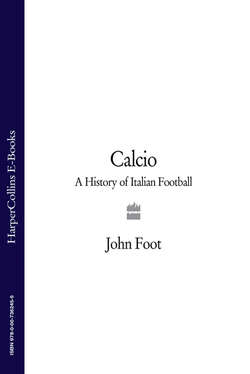Читать книгу Calcio: A History of Italian Football - John Foot - Страница 19
Early Games. Ropes, Nets and Fields
ОглавлениеWhat were early games like? Much football writing extrapolates back from contemporary soccer, assuming that matches were similar to those we see today. Yet, apart from some of the rules, the pitch, the numbers of players and the goals, very little of what was called calcio or foot-ball resembled today’s game. The players were not athletes, they rarely trained and they were, at least for the first 20–25 years, nearly all amateurs. It was only in the 1920s that the professional game, and the idea of football as a business – as a full-time occupation – really began to take root. Skill and tactics were rare, play was slow and often violent.
Games took place on impromptu fields, which were not designed specifically for football and were hardly conducive to skilful ball play. Neither was the mud that was far more common than grass in the rainy north of Italy. For some time crowds just gathered around the sidelines, or a simple rope held them back from the pitch itself. For the first ten or so years, football matches failed to attract significant crowd numbers. It was only with the birth of the national team in 1910 that the masses began to turn up to games. Four thousand people – a big crowd – attended the first ever Italian game in Milan in that year. In 1911 Italy’s first football stadium was opened, in the Marassi zone on the edge of Genoa. The stadium had a capacity of 25,000 and was bordered on one side by a large stand with seats. Genoa’s stadium was designed with dressing rooms and even a special room for the referee.
Genoa’s ground was one of the first to give a team ‘home advantage’. Just next door was the more intimate ground used by their city rivals, Andrea Doria (who would later become a part of Sampdoria). Here the crowd was so close to the pitch that a claustrophobic atmosphere was created. This ground was dubbed La Caienna, after a French prison camp. Other stadiums, usually consisting of one stand and some terracing, were constructed by Milan and other clubs before and during World War One while Venezia built a stadium on an island in 1916.
In the years before World War One, fan numbers multiplied. Away fans began to turn up to games, and groups of supporters awaited their team’s return. By the 1920s, the strongest teams had groups of organized followers, and special trains were commissioned for away games. A 1923 photograph shows a group of Genoa away fans on a station platform. They have flags, banners (viva Genoa Club) and have scrawled graffiti on the train itself – including Fan Carriage and the rather poetic and self-deprecatory phrase: Foot-ball, acute mania. These were the first groups of obsessive, faithful fans, the grandfathers (and they are all men, in the photo) of the fanatical ultrà of the 1970s and 1980s.
Were there any tactics? According to some books, early teams tended to line up in a kind of inverted pyramid formation – a sort of 2–3-5 – with emphasis on attack and on kick and rush. It was only with the professional-style training methods of the first and second decades of the twentieth century and the modern coaching of foreign managers that the game began to resemble what we see today on our screens. The various alterations to the offside rules were also important in imposing change, and players did adopt specific positions on the field, right from the beginning (although tactical discipline was slow to take root). The birth and growth of the sports press, sports writers and football correspondents boosted understanding of calcio. Certain clubs began to be associated with specific styles of play, and with particular attitudes to the game, as with the aggressive reputation of Pro Vercelli, or Inter’s association with elegance.
